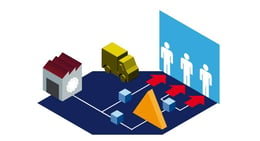What Is Logistics 4.0?
Brian Hoey - May 29, 2018

Just as the modern factory is adding new, intelligent technologies in order to create connected, interoperable workflows, the modern supply chain is rapidly becoming smarter, more networked, and more technologically advanced. Though the so-called fourth industrial revolution gets most of the attention, there is another revolution occurring simultaneously within the world of logistics, and it’s changing the way that products make their way from production facilities to customers. In the spirit of Industry 4.0, some have taken to referring to this new logistics paradigm as Logistics 4.0—but what exactly does this term mean?
Components
Industry 4.0 has been partially defined by its use of machine-to-machine communication and Internet-of-Things (IoT) devices to create factories that operate like smart homes: an array of appliances and machines are brought into constant communication in order to create a cohesive, highly visible system. In an ideal world, the end result is that areas of waste and inefficiency are uncovered, certain decisions can be more thoroughly optimized, and some simple (or not so simple) processes are automated. Logistics 4.0 operates under these same principles, but with a different set of component parts. Specifically, it makes use of “smart” containers, vehicles, pallets, and transport systems in order to create a fully networked supply stream that offers supply chain managers, shippers, freight forwarders, and others the necessary visibility to route transport and perform other logistics tasks in an optimal way.
The immediate result of the creation of a digital, networked value chain is that mission critical data becomes not just available but eminently usable. With a new degree of visibility immanent in the supply network, it becomes possible to see potential bottlenecks and breakdowns well in advance and develop countermeasures or backup plans in time to preserve smooth operations.
For instance, a supply chain manager with access to data from an IoT-enabled warehouse might be able to detect based on heat and light conditions that a particular product or group of products was likely to become damaged. Even if it were too late to prevent the damage, merely knowing about the problem would enable the warehouse to send out an order to replenish the damaged (and presumably discarded) stock. In an especially sophisticated system, the warehouse sensors could send out an alert to the supplier that a restock order was necessary without requiring any human intervention at all.
Challenges
While Logistics 4.0 represents a significant value-added proposition for those trying to navigate the complexity of the global supply chain, reaping all of the potential benefits of these technologies can present some hurdles for businesses. Three of the most significant challenges that these businesses face are:
- Reducing Shadow IT and information silos
- Breaking free from past-oriented planning
- Ditching the spreadsheet
Of these hurdles, perhaps the most important is “ditching the spreadsheet.” Not only do planners wall themselves off and actually contribute to information silos by producing plans in Excel, they also counteract the mindset of open, transparent workflows that is crucial to success in the modern supply chain. Indeed, this type of workflow is emblematic of the organizational structures that result in things like Shadow IT and siloized decision making processes, both of which make a forward-facing and future-oriented supply chain virtually impossible. Under these conditions, businesses often wind up caught in a cycle of planning based on past events and then scrambling to adjust to unforeseen breakdowns.
New Frontiers
While the demands on businesses hoping to adopt smarter logistics workflows are not to be taken lightly, they pale in scope when compared to the myriad ways in which Logistics 4.0 can add value. In the short term, boosted end-to-end (E2E) visibility and a more holistic view of the supply chain will almost certainly be significant value-added propositions for companies that are able to achieve them. Looking towards the future, Logistics 4.0 has the potential to pave the way for a new, more advanced conception of the value stream that involves autonomous vehicles (aka driverless cars), automated warehouse operations, and perhaps even the elimination of warehouses altogether in favor of predictive deliveries with full, zero-lead time integration into smart production processes.
In the last example above, we can see an instance in which these new paradigms can pave the way for the rise of “anticipatory logistics,” i.e. supply chain management in which smart technology predicts instances of demand ahead of time, enabling planners (or even autonomous machine processes) to adjust production schedules to meet future demand changes. As anticipatory logistics becomes a reality, the global value chain will become more complex, relying on advanced predictive algorithms and the integration of more and more connected elements, and simultaneously much leaner, offering a more adaptive, agile environment in which lead times are shortened significantly and shortages, overages, and all manner of disruptions are made increasingly uncommon.
If you want to learn more get your Guide to Logistics 4.0
In this Guide you will learn:
-
Why a strategic process in transportation planning is a top priority for digitalization
-
What megatrends will increase supply chain volatility
-
How to manage it
LATEST POSTS
- Understand Why Production Planning Needs Specialized Solutions
- Understand Circular Economy in The Manufacturing Industry
- How Can Industry 4.0 IT Integration Be Achieved Smoothly?
- The Significance of Order Sequencing in Discrete Manufacturing
- How to improve your Supply Chain Management: The Power of Control Towers



